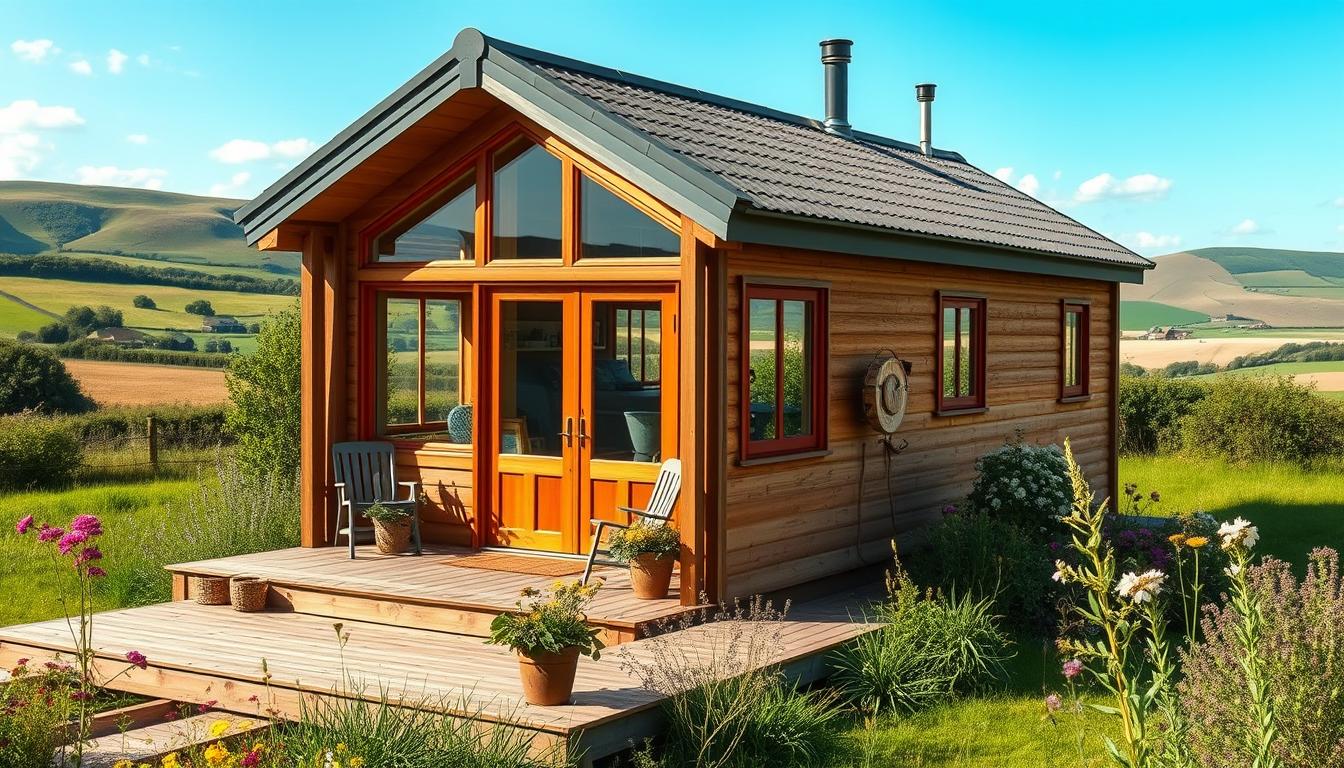Tiny house letting is becoming popular in the UK. Property owners see it as a way to make more money and live more sustainably. This guide will help you turn your property into a tiny house rental. It covers everything from the tiny house trend to legal stuff.
If you’re new to renting out property, this guide is for you. More people in the UK want affordable, green homes. Tiny houses offer a great chance to earn extra money.
We’ll show you how to pick the best land and set up your tiny house. You’ll learn about creating a rental agreement and marketing your property. This guide will help you make the most of the tiny house trend. You’ll offer unique homes and earn extra cash.
Key Takeaways
- Understanding the increasing popularity and economic benefits of tiny house letting in the UK.
- Essential legal considerations and planning permissions required for renting out a tiny house.
- Steps to choose the right land for your tiny house placement.
- Guidance on setting up and equipping your tiny house for rent, ensuring compliance with UK regulations.
- Effective marketing strategies to attract tenants to your tiny house rental.
- Tips for creating a solid rental agreement and managing your tiny house property smoothly.
Understanding the Tiny House Trend in the UK
In recent years, tiny homes have become very popular in the UK. This is due to economic pressures and changing lifestyle choices. These small homes, ranging from 100 to 400 square feet, are much smaller than usual homes. Yet, they are attracting many, especially millennials and downsizing retirees.
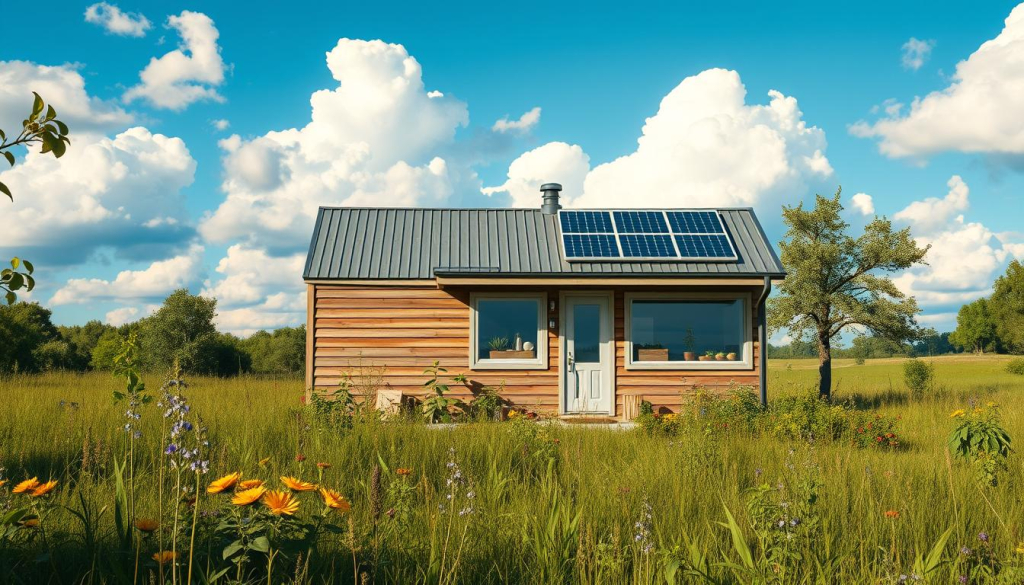
The Popularity of Tiny Homes
The appeal of tiny homes is clear. There are about 200 officially recognised micro homes in the UK. These include shipping containers, eco-cabins, and van conversions. This variety meets different tastes, making tiny homes a flexible housing option.
Moreover, tiny homes reflect a wider desire for sustainable living and simpler lifestyles. They are part of a broader trend towards minimalism and financial prudence.
Changing Lifestyle Choices
UK citizens are moving towards minimalism and saving money. Traditional homes cost around £290,000, needing a £50,000 deposit. Tiny homes, priced between £30,000 to £100,000, offer a big financial advantage.
These homes are part of a movement towards simpler, hassle-free living. The Office for National Statistics shows an increase in households living in tiny houses. This highlights the shift towards these homes.
Economic Benefits
Tiny homes save a lot of money. They can save £780 to £1,057 each month, based on 2020 data. This is a big saving compared to traditional housing costs.
The initial cost of a tiny home, starting at £6,500, offers long-term financial freedom. They also use less energy and materials, making them sustainable and environmentally friendly. Tiny homes are a cost-effective option in today’s housing market.
The UK tiny house market is growing fast. It is expected to grow by 4.88% each year from 2022 to 2027.
Renting a Tiny House on Your Property
Thinking about renting a tiny house on your land? It’s important to know the UK laws. You need to understand the planning permission process. This ensures your tiny house rental is legal and beneficial for you.
Legal Considerations
There are many legal steps to take when renting out a tiny house. You must check zoning laws and tenancy rules. Tiny houses are often seen as caravans or mobile homes if they’re on wheels and meet size criteria.
In the UK, tiny houses over 2.55m wide can’t be driven on roads. They must be under 7 meters long to be towed with a standard licence. The Caravan Sites and Control of Development Act 1960 lets you park a tiny house in your driveway or garden. But, it can’t be used as a separate home.
It’s crucial to follow these rules to avoid legal problems. This way, you can enjoy the benefits of renting a tiny house.
Understanding Planning Permission
Planning permission is key when renting a tiny house. You need it if you want to use the tiny house as a main home or add it to your farm. UK laws say a tiny house in your garden might not pay council tax if it’s extra living space.
This can save you money. For more details, see the full blog post on understanding the UK laws of a tiny.
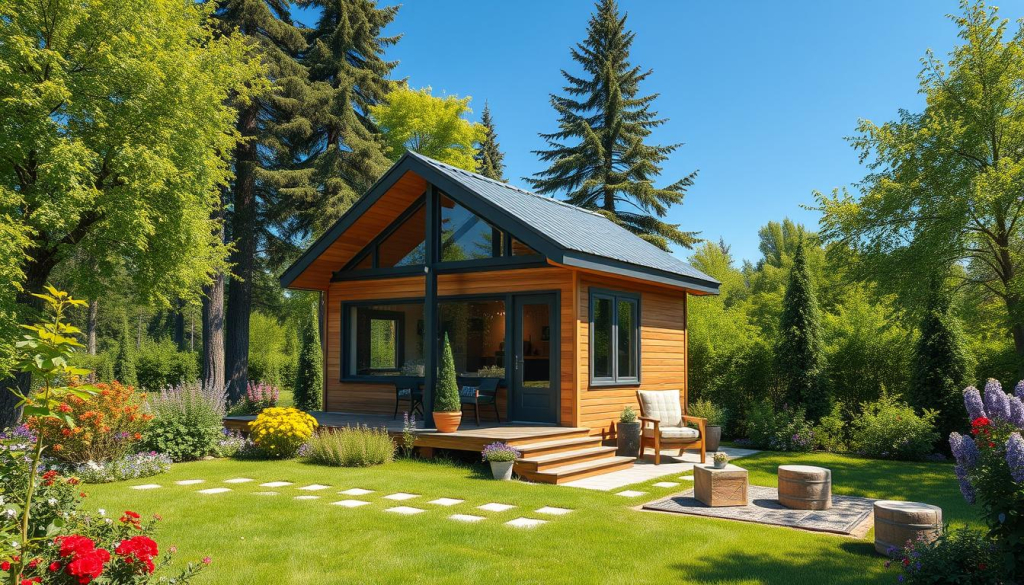
Benefits for Homeowners
There are many benefits to renting out a tiny house. It can bring in extra money and even increase your property’s value. Tiny houses are cheaper to build, costing about 20% less than regular homes.
They cost between £50,000 to £65,000. Rentals can also benefit from the growing interest in tiny homes. This can be a great way to make more money from your property. For more info, check out this guide on renting a tiny house on your.
Choosing the Right Land for Your Tiny House
Finding the perfect land for your tiny house is key. You have many options, each with its own benefits. We’ll look at park home sites, farmland, renting from friends or family, and DIY farms.
Park Home Sites
Park home sites offer a great living environment with all the basics. They often have water and electricity ready for you. But, remember, tiny homes over 3.05m tall might not fit in most places. Always check local laws before you decide.
Farm Land
Choosing farm land for your tiny home means lots of space. Prices vary, but you could earn money from equestrian activities. Make sure to read your rental agreement carefully, as some rules might apply.
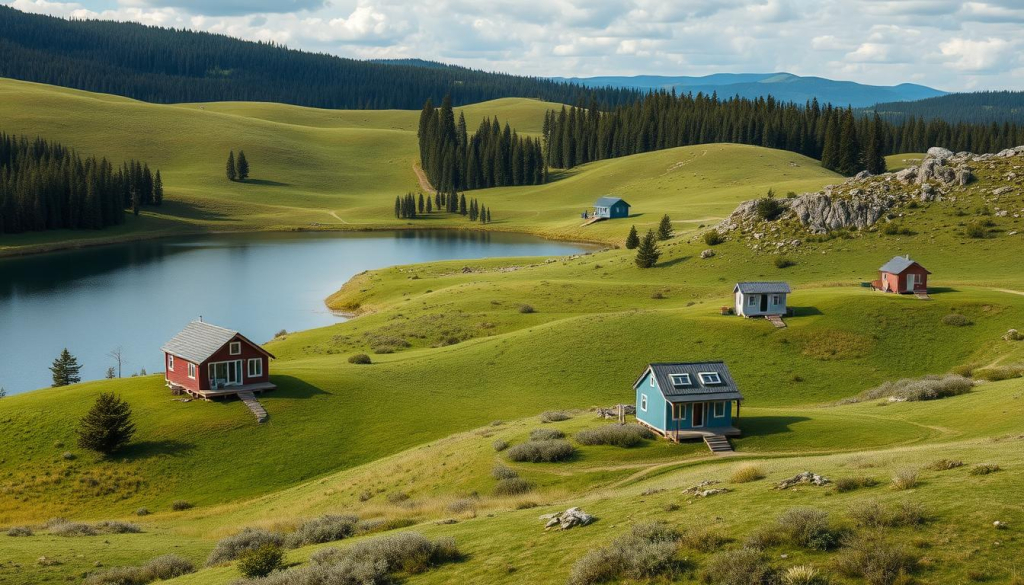
Rented Land from Friends or Family
Renting from friends or family is a cost-effective choice. It often comes with a supportive community. Rent can be £200 to £300 a month, including bills. Using your network can help you find great options.
DIY Farms/Smallholdings
DIY farms offer a chance to live sustainably. If you’re handy, you can build your dream tiny home. Land prices vary, but you’ll need to think about planning rules.
Knowing what you want will help you choose the best land. Whether it’s the ease of park home sites, the peace of farmland, the support of friends, or the freedom of DIY, the right spot is out there.
Setting Up Your Tiny House for Rent
Setting up your tiny house rental can be both rewarding and challenging. Success comes from having all the necessary amenities and utilities. You also need to follow UK laws and create detailed tenant agreements.
Essential Amenities and Utilities
To make your tiny house rental a success, you must provide essential amenities and utilities. This ensures your tenants are comfortable. Here are some key things to include:
- Water Supply: A reliable water source is crucial. This can be a mains supply or water storage solutions.
- Electricity: Your tiny house should be connected to the grid or have alternative power like solar panels.
- Heating and Cooling Systems: Choose efficient HVAC systems that fit your tiny house’s space.
- Sanitation: Proper sewage or septic systems are needed to manage waste effectively.
- Internet Access: A stable internet connection is essential in today’s digital world.
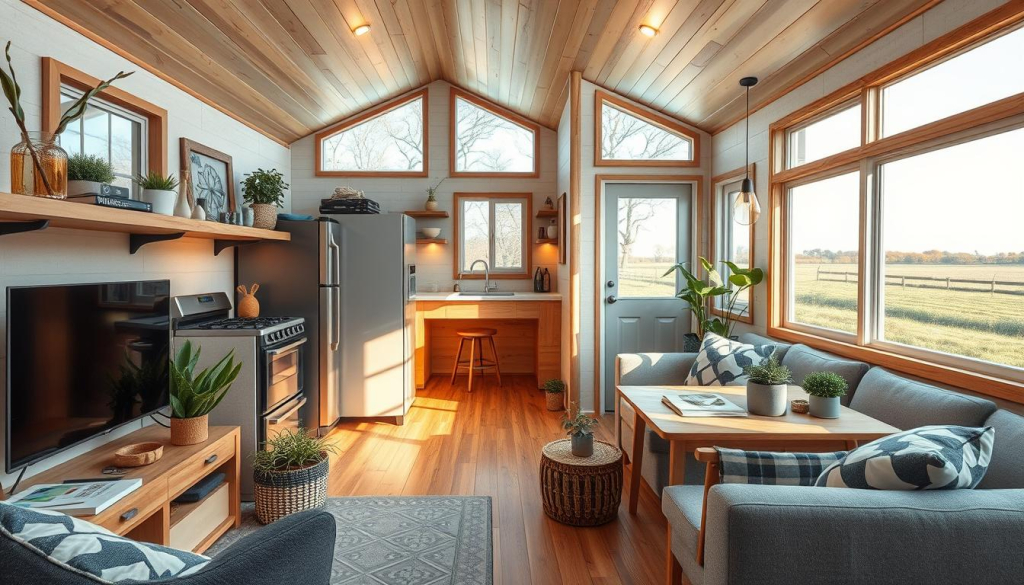
Ensuring Compliance with UK Regulations
Following UK regulations is vital for rental compliance. This means meeting safety standards and respecting tenant rights. Here are some important considerations:
- Planning Permission: Check with local councils if you need planning permission for your tiny house, especially if it’s permanent.
- Building Regulations: Make sure your tiny house meets UK building regulations, covering structural integrity and fire safety.
- Energy Performance Certificate (EPC): An EPC rating shows the property’s energy efficiency.
- Insurance: Both landlords and tenants need suitable insurance to protect against risks.
Creating a Rental Agreement
Creating a clear tenant agreement is crucial. It protects both the homeowner and the tenant. Include these key elements in your agreements:
- Duration: State if the agreement is for short-term (less than 6 months) or long-term (over 6 months) stays.
- Rent Amount and Payment Details: Mention the rent, payment methods, and due dates.
- Maintenance Responsibilities: Explain which maintenance tasks the tenant and homeowner are responsible for.
- Access and Use of Land: Clearly outline the terms for land use and access, especially with license agreements.
- Termination Clauses: Include conditions for terminating the agreement by either party.
By following these guidelines, you can set up your tiny house rental for success. This ensures legal compliance and tenant satisfaction. It also helps provide a high standard of living for tenants and secures your investment in the UK’s tiny house rental market.
Marketing and Managing Your Tiny House Rental
Marketing and managing your tiny house rental is key to attracting the right tenants. With a rise in demand for tiny cabin rentals, it’s a great time to enter this market. Here are some tips to help you market and manage your property.
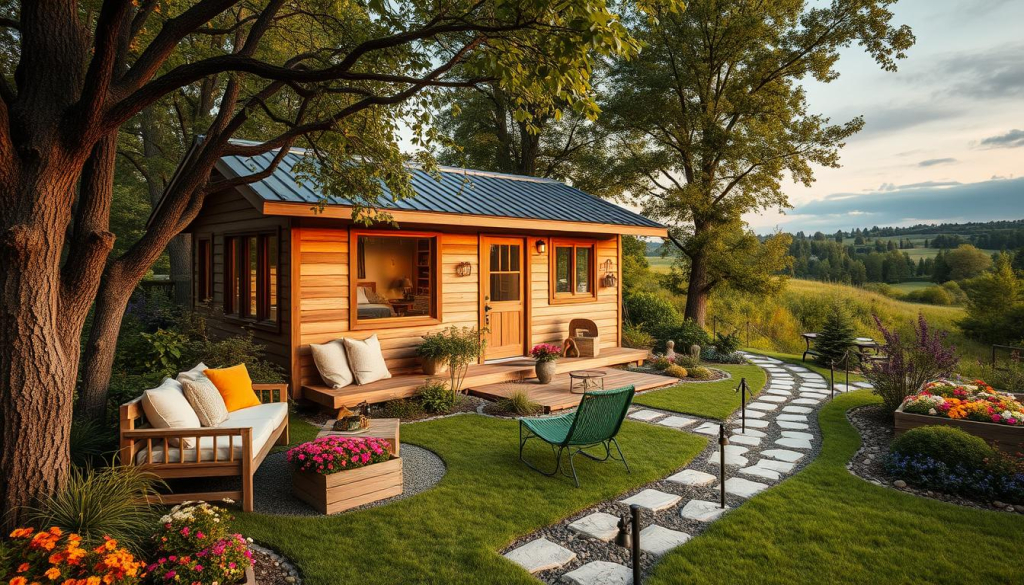
First, market your tiny house as a unique and desirable living space. Use social media, especially Instagram, to reach potential tenants. Engage with tiny house communities online to connect with your target audience.
Here are some steps to boost your marketing:
- High-Quality Photos: Use professional photos to show off your tiny house’s interior and exterior. Highlight its unique features and space-saving design.
- Detailed Description: Give a detailed description of your property, including amenities and unique selling points. Mention any smart tech integrations, which are cost-effective in tiny houses.
- Social Media Campaigns: Use influencer collaborations and social media to increase your reach. Influencers can showcase the benefits of tiny house living.
- Local Advertising: Post in local community boards and newspapers to attract tenants in your area.
Efficiently managing your property rentals is also vital. Use digital tools for managing rentals to simplify the process. Platforms like Hemlane or Property Hawk offer features for tenant screening, agreements, and payment tracking.
Finding the right tenants is crucial. Have a solid tenant screening process:
- Background Checks: Do thorough background checks to ensure applicants have a clean record and reliable rental history.
- Credit Checks: Check applicants’ financial stability through credit checks to lower default risks.
- References: Ask for and review references from previous landlords or employers to assess the tenant’s reliability and character.
By following these marketing and management tips, your tiny house rental will attract quality tenants. This will ensure a steady income and a rewarding investment.
Conclusion
Starting a tiny house letting business in the UK can be very rewarding. It’s a chance for property owners to explore new ways to make money. Knowing the tiny home market well is key to success.
Following the law is essential. This means sticking to rules about building and getting the right permissions. This helps avoid problems and makes things smoother.
Where you place your tiny house matters a lot. It could be on a farm, rented land, or even a friend’s property. The location affects how appealing and profitable it can be.
Make sure your tiny house has all the basics and meets UK standards. This makes it more attractive to renters. It also helps you get more people staying and earning more money.
Marketing and managing your tiny house well is crucial. Good marketing draws in the right tenants. Meanwhile, careful management keeps everything running smoothly and tenants happy. This guide is here to help property owners succeed in tiny house letting. It’s a smart and lasting way to invest in the UK.


